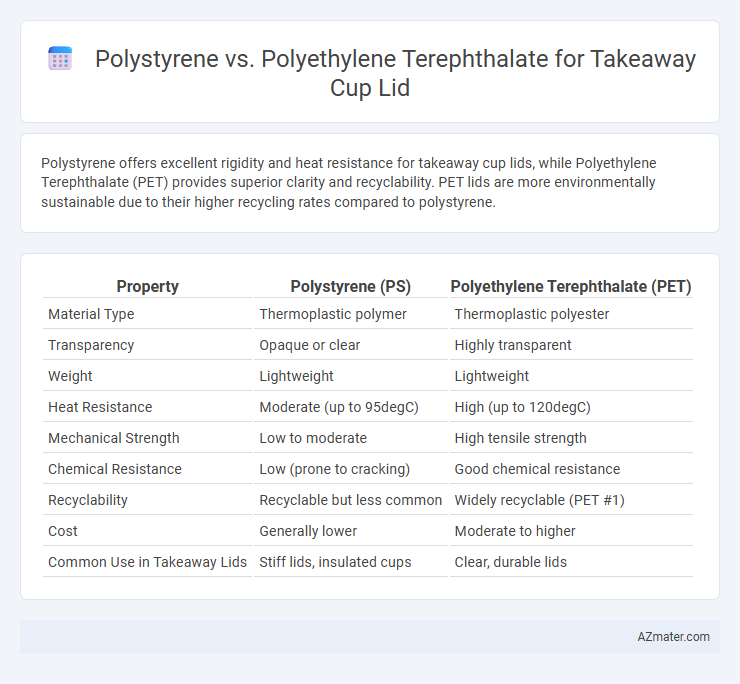Polystyrene offers excellent rigidity and heat resistance for takeaway cup lids, while Polyethylene Terephthalate (PET) provides superior clarity and recyclability. PET lids are more environmentally sustainable due to their higher recycling rates compared to polystyrene.
Table of Comparison
| Property | Polystyrene (PS) | Polyethylene Terephthalate (PET) |
|---|---|---|
| Material Type | Thermoplastic polymer | Thermoplastic polyester |
| Transparency | Opaque or clear | Highly transparent |
| Weight | Lightweight | Lightweight |
| Heat Resistance | Moderate (up to 95degC) | High (up to 120degC) |
| Mechanical Strength | Low to moderate | High tensile strength |
| Chemical Resistance | Low (prone to cracking) | Good chemical resistance |
| Recyclability | Recyclable but less common | Widely recyclable (PET #1) |
| Cost | Generally lower | Moderate to higher |
| Common Use in Takeaway Lids | Stiff lids, insulated cups | Clear, durable lids |
Introduction: The Battle of Plastics in Takeaway Cup Lids
Polystyrene (PS) and Polyethylene Terephthalate (PET) dominate the takeaway cup lid market due to their distinct material properties. PS offers excellent rigidity and insulation, making it a popular choice for hot beverages, while PET boasts superior clarity, strength, and recyclability, ideal for cold drinks. The contrasting features in durability, environmental impact, and manufacturing costs drive the ongoing evaluation between these two plastics in sustainable packaging solutions.
Material Overview: What are Polystyrene and Polyethylene Terephthalate?
Polystyrene (PS) is a synthetic aromatic hydrocarbon polymer derived from the monomer styrene, commonly used in disposable food containers and lids due to its rigidity and ease of molding. Polyethylene Terephthalate (PET) is a thermoplastic polymer resin from the polyester family, known for its high strength, clarity, and resistance to moisture, frequently utilized in food and beverage packaging. Both materials vary significantly in terms of mechanical properties, thermal resistance, and environmental impact, influencing their suitability for takeaway cup lids.
Manufacturing Differences: Production of Polystyrene vs PET Lids
Polystyrene lids for takeaway cups are produced through a process called injection molding, which involves melting polystyrene pellets and injecting the molten polymer into a mold to create rigid, lightweight lids. Polyethylene terephthalate (PET) lids are typically manufactured using thermoforming, where PET sheets are heated to a pliable temperature and then formed over molds to achieve the desired shape, offering superior clarity and chemical resistance. The injection molding process for polystyrene allows rapid cycle times and lower material costs, while PET's thermoforming requires precise temperature control to maintain its strength and transparency, influencing production speed and energy consumption.
Physical Properties: Strength, Flexibility, and Clarity Compared
Polystyrene offers excellent clarity and rigidity, making it ideal for clear takeaway cup lids that require a sturdy structure. Polyethylene terephthalate (PET) provides superior strength and flexibility, enhancing impact resistance and reducing brittleness under stress. While polystyrene is more brittle and less flexible, PET balances durability with transparency, improving overall performance in lid applications.
Temperature Resistance: Performance with Hot and Cold Beverages
Polystyrene offers moderate temperature resistance suitable for cold and mild hot beverages but can deform or release chemicals at higher temperatures, limiting its use with very hot drinks. Polyethylene Terephthalate (PET) provides superior thermal stability, maintaining structural integrity and safety for both hot and cold beverages up to approximately 70-80degC. PET's enhanced heat resistance and clarity make it a preferred material for takeaway cup lids requiring performance with varying beverage temperatures.
Environmental Impact: Recycling and Biodegradability
Polystyrene lids for takeaway cups present significant environmental challenges due to their low recycling rates and slow biodegradability, often accumulating in landfills and oceans for centuries. In contrast, polyethylene terephthalate (PET) lids are more widely recycled through established programs, reducing landfill waste and environmental pollution. PET's chemical structure allows for more efficient recycling processes, although both materials require improved management to fully mitigate their ecological footprints.
Consumer Safety: Toxicity and Food Contact Considerations
Polystyrene (PS) and Polyethylene Terephthalate (PET) differ significantly in consumer safety for takeaway cup lids, with PET generally regarded as safer due to its lower potential for chemical leaching and better heat resistance. Polystyrene can release styrene monomers, which are considered potentially harmful when in contact with hot beverages, raising toxicity concerns. Regulatory bodies such as the FDA approve PET for direct food contact, emphasizing its superior safety profile in minimizing contaminant migration into drinks.
Cost Analysis: Economics of Polystyrene and PET Lids
Polystyrene lids typically offer a lower production cost due to cheaper raw materials and simpler manufacturing processes, making them budget-friendly for high-volume takeaway cup applications. Polyethylene Terephthalate (PET) lids, while more expensive initially, provide better durability, recyclability, and consumer appeal, which can translate to long-term savings in waste management and brand value. Economic decisions between PS and PET should weigh upfront expenses against environmental compliance costs and customer preferences for sustainable packaging.
Market Trends: Industry Preferences and Innovations
The takeaway cup lid market is increasingly favoring Polyethylene Terephthalate (PET) due to its superior recyclability and clarity compared to Polystyrene (PS), which faces decline amid environmental concerns and stricter regulations. Innovations in PET materials, such as enhanced barrier properties and bio-based PET options, align with growing demand for sustainable packaging solutions. Industry preferences reflect a shift towards lightweight, durable, and eco-friendly lids, positioning PET as the dominant material in evolving takeaway packaging trends.
Final Verdict: Choosing the Right Lid Material for Sustainability and Function
Polystyrene lids offer excellent rigidity and heat resistance, making them ideal for hot beverage containment, but they pose significant environmental challenges due to poor biodegradability and recycling difficulties. Polyethylene Terephthalate (PET) lids provide superior recyclability and a lower environmental footprint, aligning better with sustainable packaging initiatives, though they may lack the same thermal insulation properties as polystyrene. Selecting PET lids supports circular economy goals and reduces plastic waste, making them the more sustainable and functionally balanced choice for takeaway cup lids in eco-conscious markets.

Infographic: Polystyrene vs Polyethylene Terephthalate for Takeaway Cup Lid
 azmater.com
azmater.com